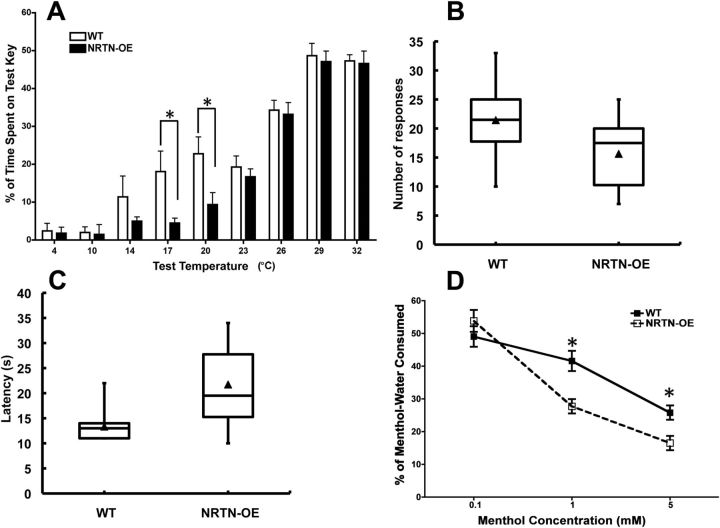Figure 6.
NRTN-OE mice have increased sensitivity to innocuous cold temperature and oral menthol. A, A two-temperature choice test was performed in which mice explored two adjacent temperature-controlled keys for 5 min. The control key was held at a constant 32°C, whereas the test key ranged from 4°C to 32°C. Data are plotted as percentage of time spent on the test key (y-axis) as a function of test temperature (x-axis). No preference was displayed by NRTN-OE (n = 20) or WT (n = 20) mice at test temperatures of 29°C and 32°C (i.e., they spent ∼50% of the time on both keys). When the temperature of the test key was <29°C, both NRTN-OE and WT mice spent less time on the test key relative to the control key, indicating a preference for 32°C. NRTN-OE mice spent significantly less time than WT mice at the 17°C and 20°C test temperatures. *NRTN-OE < WT (t tests; at each temperature). B, NRTN-OE mice have decreased sensitivity to noxious cold on wet ice block. Plot shows that NRTN-OE mice placed on a −20°C surface have a longer latency to their first nocifensive response than WT mice (p < 0.05; t test). C, NRTN-OE mice also had fewer responses during the ice block trial period (p < 0.05; t test). D, WT (n = 6) and NRTN-OE (n = 6) mice were tested for oral sensitivity to menthol using a two-bottle drinking aversion assay. One bottle contained water with vehicle (0.07% ethanol), and the other bottle contained water with menthol (0.1, 1, and 5 mm). At the lowest concentration (0.1 mm), both WT and NRTN-OE mice drank equal amounts of vehicle and menthol solutions, exhibiting no preference. At menthol concentrations of 1 and 5 mm, both WT and NRTN-OE mice drank less menthol solution compared with baseline, and NRTN-OE mice drank significantly less menthol-water than WT mice. *NRTN-OE < WT (p < 0.05; two-way ANOVA and Bonferroni post hoc test).

